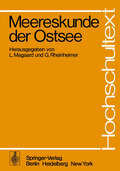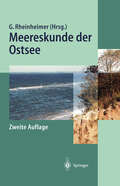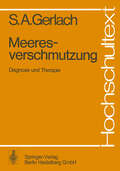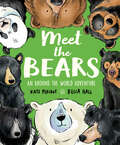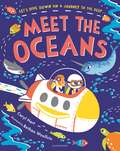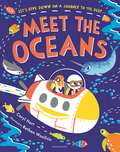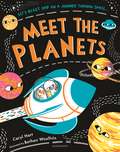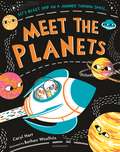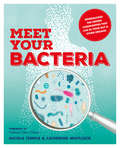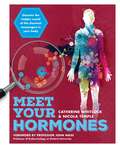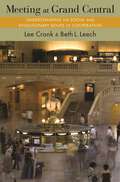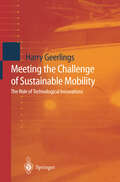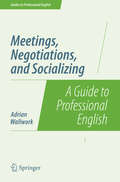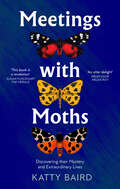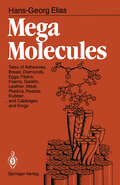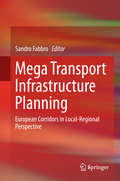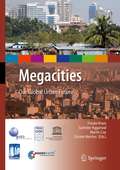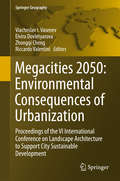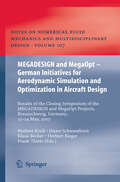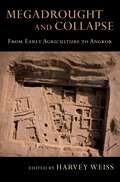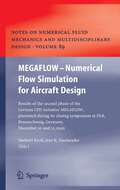- Table View
- List View
Meereskunde der Ostsee
by D. NehringUm die Ostsee als Lebensraum zu erhalten, ist eine umfassende Analyse und ein ständiges Überwachen der ökologischen Parameter nötig.Renommierte Forscher der großen Ostseeinstitute beschreiben in der "Meereskunde der Ostsee" alle wesentlichen Aspekte, die das Ökosystem Ostsee ausmachen: Klima, Geologie, Pflanzen, Tiere, industrielle Nutzung und Belastung, mögliche Schutzmaßnahmen. Das Thema wird gut verständlich dargestellt und durch zahlreiche, zum Teil farbige Abbildungen veranschaulicht.Nicht nur Fachkundigen, sondern auch Laien und "Ostseeliebhabern" wird mit diesem Buch aktuelles Hintergrundwissen vermittelt.
Meet The Bears (Meet The…)
by Kate PeridotPack your teddy and your bear-proof lunchbox and join us on a thrilling international adventure to meet the world's eight species of bears. From polar bears to giant pandas, from spectacled bears to the asiatic moon bears, find out what makes bears so amazing. But what sort of bear is your teddy?Includes a map of the world showing bear hotspots and a bear size comparison spread.
Meet the Oceans
by Caryl HartSPLOOOOSH! We're off on an exciting underwater adventure in our submarine to meet the oceans and seas of our blue planet.Join in with the rhymes and get ready to spot all the smiley-faced, friendly oceans, from the Atlantic and deep Pacific to the sparkling Mediterranean. Little ones will have a whale of a time (and be back in time for bed!) in this striking, story-led picture book. This bold, bright follow-up to the acclaimed picture book Meet the Planets is packed with sea creatures from dolphins and beluga whales to turtles and manatees. The ocean is a vast treasure-house, threatened by plastic waste and pollution, and this picture book is the ideal introduction to the importance of caring for it. It's perfect for all would-be explorers!
Meet the Oceans
by Caryl HartSPLOOOOSH! We're off on an exciting underwater adventure in our submarine to meet the oceans and seas of our blue planet.Join in with the rhymes and get ready to spot all the smiley-faced, friendly oceans, from the Atlantic and deep Pacific to the sparkling Mediterranean. Little ones will have a whale of a time (and be back in time for bed!) in this striking, story-led picture book. This bold, bright follow-up to the acclaimed picture book Meet the Planets is packed with sea creatures from dolphins and beluga whales to turtles and manatees. It's perfect for all would-be explorers!This audio-enabled edition comes with a gorgeous reading by Sarah Ovens, along with music and sound effects.
Meet the Planets
by Caryl HartZoooooooom! We're off on an exciting space adventure in our rocket to meet all the planets of the solar system.Join in with the rhymes and spot all the smiley-faced, friendly planets, from shimmering Saturn to mighty Mars. Little ones will have a blast (and be back in time for bed!) in this striking, read-aloud, story-led picture book. It's perfect for all would-be astronauts!
Meet the Planets
by Caryl HartZoooooooom! We're off on an exciting space adventure in our rocket to meet all the planets of the solar system.Join in with the rhymes and spot all the smiley-faced, friendly planets, from shimmering Saturn to mighty Mars. Little ones will have a blast (and be back in time for bed!) in this striking, read-aloud, story-led picture book. It's perfect for all would-be astronauts!A special edition where the words and pictures take you on a journey far beyond the page. This audio-enabled eBook comes with a gorgeous reading by Sarah Ovens, along with music and sound effects.
Meet Your Bacteria: The Hidden Communities That Live In Your Gut And Other Organs (Meet your...)
by Catherine Whitlock Nicola TempleMeet Your Bacteria introduces you to all of your tiny tenants, and reveals the fascinating inner workings of your body, and the importance of these usually helpful (but sometimes harmful) microbes.Highly topical and accessible, this book:- Explores the different bacteria that live on and in various parts of your body (not just in the gut)- Explains what they do, and why some are beneficial and some harmful- Offers practical advice for promoting the good and inhibiting the bad bacteria- Examines the latest thinking on good and bad dirt, and the links between bacteria and diseaseIncluding in-depth profiles on each of the most important families of bacteria living in the human body, and helpful advice on how you can look after your own health through greater knowledge of your microbial friends, this is a wide-ranging introduction to the secret world inside your own body.
Meet Your Hormones: Discover The Hidden World Of The Chemical Messengers In Your Body (Meet your...)
by Catherine Whitlock Nicola TempleForeword by Professor John Wass, Professor of Endocrinology at Oxford UniversityDid you know that you have thousands, perhaps millions, of hormones in your bloodstream?Did you know that these complex chemical messengers regulate the function of our cells and organs?Or that they keep our bodies working properly, co-ordinating processes like growth, fertility and metabolism?Meet Your Hormones explores and explains the fascinating world of hidden hormones: what they are, what they do and why you can't live without these super-fast chemical messengers. Including in-depth profiles on each of the most important hormones at work in the human body, and helpful advice on how you can look after your own health through greater knowledge of your hormones, this is a wide-ranging introduction to the secret world inside your own body.This book:- Explores what hormones are, where they are made and how they work - Explains the key functions of the body in which they are involved - Offers practical advice on how we can help our hormones help us through diet and lifestyle - Examines the latest thinking and cutting-edge research - Forms a companion volume to Meet Your Bacteria
Meeting at Grand Central: Understanding the Social and Evolutionary Roots of Cooperation
by Lee Cronk Beth L. LeechFrom the family to the workplace to the marketplace, every facet of our lives is shaped by cooperative interactions. Yet everywhere we look, we are confronted by proof of how difficult cooperation can be--snarled traffic, polarized politics, overexploited resources, social problems that go ignored. The benefits to oneself of a free ride on the efforts of others mean that collective goals often are not met. But compared to most other species, people actually cooperate a great deal. Why is this? Meeting at Grand Central brings together insights from evolutionary biology, political science, economics, anthropology, and other fields to explain how the interactions between our evolved selves and the institutional structures we have created make cooperation possible. The book begins with a look at the ideas of Mancur Olson and George Williams, who shifted the question of why cooperation happens from an emphasis on group benefits to individual costs. It then explores how these ideas have influenced our thinking about cooperation, coordination, and collective action. The book persuasively argues that cooperation and its failures are best explained by evolutionary and social theories working together. Selection sometimes favors cooperative tendencies, while institutions, norms, and incentives encourage and make possible actual cooperation. Meeting at Grand Central will inspire researchers from different disciplines and intellectual traditions to share ideas and advance our understanding of cooperative behavior in a world that is more complex than ever before.
Meeting at Grand Central: Understanding the Social and Evolutionary Roots of Cooperation
by Lee Cronk Beth L. LeechFrom the family to the workplace to the marketplace, every facet of our lives is shaped by cooperative interactions. Yet everywhere we look, we are confronted by proof of how difficult cooperation can be--snarled traffic, polarized politics, overexploited resources, social problems that go ignored. The benefits to oneself of a free ride on the efforts of others mean that collective goals often are not met. But compared to most other species, people actually cooperate a great deal. Why is this? Meeting at Grand Central brings together insights from evolutionary biology, political science, economics, anthropology, and other fields to explain how the interactions between our evolved selves and the institutional structures we have created make cooperation possible. The book begins with a look at the ideas of Mancur Olson and George Williams, who shifted the question of why cooperation happens from an emphasis on group benefits to individual costs. It then explores how these ideas have influenced our thinking about cooperation, coordination, and collective action. The book persuasively argues that cooperation and its failures are best explained by evolutionary and social theories working together. Selection sometimes favors cooperative tendencies, while institutions, norms, and incentives encourage and make possible actual cooperation. Meeting at Grand Central will inspire researchers from different disciplines and intellectual traditions to share ideas and advance our understanding of cooperative behavior in a world that is more complex than ever before.
Meeting the Challenge of Sustainable Mobility: The Role of Technological Innovations
by Harry GeerlingsProviding new insights into the relationship between transport and the environment, and the meaning of the concept of sustainable development for the transport sector, special attention is paid to the relationship between technological progress and policy. The different theoretical approaches are combined to create a strategy for R&D and the implementation of mega-technological innovations. The author deals with two specific cases: Maglev technology and fuel-cell technology for transport purposes. Taking into account the new theoretical insights and the empirical findings, the resulting synthesis and conclusions are important for researchers and professionals in transportation, environmental sciences and related fields.
Meetings, Negotiations, and Socializing: A Guide to Professional English (Guides to Professional English)
by Adrian WallworkThis book is a guide to taking part in meetings and negotiations, and to the socializing required before and after such events. If you are a non-native English speaker, with an intermediate level and above, and you work for a company with international relations, then this book is the solution to all your English problems!Four main topics are covered:1. Meetings2. Negotiations3. Socializing4. How to understand fast-speaking native English speakersThis book is designed to be used like a manual or user guide - you don't need to read it starting from page 1. Like a manual it has lots of short subsections, and is divided into short paragraphs with many bullet points. This is to help you find what you want quickly and also to assimilate the information as rapidly and as effectively as possible. The book concludes with a chapter of useful phrases.There is an introduction for trainers on how to teach the skills required for meetings, negotiations and socializing in Business / Commercial English.
Meetings with Moths: Discovering Their Mystery And Extraordinary Lives
by Katty BairdMossy greens, conker browns, cream, chocolate and deepest black; add stripes, swirls and splotches and you have some of the most striking wildlife Britain has to offer.
Meetings with Remarkable Mushrooms: Forays with Fungi across Hemispheres
by Alison PouliotA whirlwind journey through fungus frontiers that underscores how appreciating fungi is key to understanding our planet’s power and fragility. What can we learn from the lives of fungi? Splitting time between the northern and southern hemispheres, ecologist Alison Pouliot ensures that she experiences two autumns per year in the pursuit of fungi—from Australia’s deserts to Iceland’s glaciers to America’s Cascade Mountains. In Meetings with Remarkable Mushrooms, we journey alongside Pouliot, magnifiers in hand, as she travels the world. With Pouliot as our guide, we smell fire-loving truffles that transform their scent after burning to lure mammals who eat them and, ultimately, spread their spores. We spot the eerie glow of the ghost fungus, a deceptive entity that looks like an edible oyster mushroom but will soon heave back out—along with everything else in your stomach—if you take a bite. And we crawl alongside vegetable caterpillars, which are neither vegetable nor caterpillar but a fungus that devours insects from the inside out. Featuring stunning color photographs of these mycological miracles, Meetings with Remarkable Mushrooms shows that understanding fungi is fundamental for harmonizing with the natural world.
Meetings with Remarkable Mushrooms: Forays with Fungi across Hemispheres
by Alison PouliotA whirlwind journey through fungus frontiers that underscores how appreciating fungi is key to understanding our planet’s power and fragility. What can we learn from the lives of fungi? Splitting time between the northern and southern hemispheres, ecologist Alison Pouliot ensures that she experiences two autumns per year in the pursuit of fungi—from Australia’s deserts to Iceland’s glaciers to America’s Cascade Mountains. In Meetings with Remarkable Mushrooms, we journey alongside Pouliot, magnifiers in hand, as she travels the world. With Pouliot as our guide, we smell fire-loving truffles that transform their scent after burning to lure mammals who eat them and, ultimately, spread their spores. We spot the eerie glow of the ghost fungus, a deceptive entity that looks like an edible oyster mushroom but will soon heave back out—along with everything else in your stomach—if you take a bite. And we crawl alongside vegetable caterpillars, which are neither vegetable nor caterpillar but a fungus that devours insects from the inside out. Featuring stunning color photographs of these mycological miracles, Meetings with Remarkable Mushrooms shows that understanding fungi is fundamental for harmonizing with the natural world.
Mega Molecules: Tales of Adhesives, Bread, Diamonds, Eggs, Fibers, Foams, Gelatin, Leather, Meat, Plastics, Resists, Rubber, ... and Cabbages and Kings
by Hans-Georg EliasAll life is based on big molecules, scientifically called "mac romolecules". Humans, animals, and plants cease to exist without these structural, reserve, and transport molecules. No life can be propagated without macromolecular DNA and RNA. Without macromolecules, we would only dine on water, sugars, fats, vitamins and salts but had to relinquish meat, eggs, cereals, vegetables, and fruits. We would not live in houses since wood and many stones consist of macromole cules. Without macromolecules, no clothes since all fibers are made from macromolecules. No present-day car could run: All tires are based on macromolecules. Without macromole cules no photographic films, no electronics ... If macromolecules are so important then why is commonly so little known about their roles and why are they so little mentioned in school, if at all? As often in human history, tra dition is important and science makes no exception. Chemis try was established as the chemistry of low molecular weight compounds since these were most easy to investigate, charac terize, and convert. A beautiful tower of thought was erected by the chemical sciences long before the idea of giant mole cules, macromolecules, took hold. There was no space for newcomers in this tower. Even today one can learn about chemistry without hearing a word about macromolecules.
Mega Transport Infrastructure Planning: European Corridors in Local-Regional Perspective
by Sandro FabbroBased on the work of Poly5, or the Mediterranean Corridor, mega-transport infrastructure project, this ground-breaking reference explains how and why traditional top-down government-defined transport planning policies are failing, due to their tendency to eschew acknowledgement of profoundly multifarious local and regional issues. The authors use cognitive reports from the Mediterranean Corridor experience as a learning platform, unpacking the tangled sources of the challenges faced to find firm ground from which to embark upon future projects. They propose the replacement of the current fragmented and unbalanced implementation efforts across various territories with a bottom-up, holistic, inclusive approach in which individual territories and regions have buy-in from the outset, a chance to bring their strengths to bear on the broader infrastructural planning, an ongoing communication channel to report and tackle difficulties and clear, strategic directives to drive sustainable future growth of environmentally desirable and practical mega-transport systems.
Megacities: Our Global Urban Future (International Year of Planet Earth)
by Frauke Kraas Surinder Aggarwal Martin Coy Günter MertinsAs urbanization continues, and even accelerates, scientists estimate that by 2015 the world will have up to 60 ‘megacities’ – urban areas with more than five million inhabitants. With the irresistible economic attractions of urban centers, particularly in developing countries, making the influx of citizens unstoppable, many of humankind’s coming social, economic and political dramas will be played out in megacities. This book shows how geographers and Earth scientists are contributing to a better understanding of megacities.The contributors analyze the impact of socio-economic and political activities on environmental change and vice versa, and identify solutions to the worst problems. They propose ways of improving the management of megacities and achieving a greater degree of sustainability in their development. The goals, of wise use of human and natural resources, risk reduction (both social and environmental) and quality of life enhancement, are agreed upon. But, as this text proves, the means of achieving these ends are varied. Hence, chapters cover an array of topics, from health management in Indian megacities, to planning in New York, to transport solutions for the chronically traffic-choked Bangkok. Authors cover the impact of climate change on megacities, as well as less tangible issues such as socio-political fragmentation in the urban areas of Rio de Janeiro.This exploration of some of the most crucial issues that we face as a species sets out research that is of the utmost importance, with the potential to contribute substantially to global justice and peace – and thereby prosperity.
Megacities 2050: Proceedings of the VI International Conference on Landscape Architecture to Support City Sustainable Development (Springer Geography)
by Viacheslav I. Vasenev Elvira Dovletyarova Zhongqi Chen Riccardo ValentiniThis interdisciplinary proceedings book addresses highly relevant topics in urbanization and its environmental impacts and presents case studies revealing the negative environmental consequences of the anthropogenic and technogenic pressures. Urbanization is an important trend in current land-use change, with up to 70% of the world population projected to live in cities by 2050. How will this rapid urbanization alter the face of Europe? What are the environmental consequences of the expansion of megacities? These and other important questions are addressed in the Megacities 2050 Proceedings of the VI International Conference on Landscape Architecture to Support City Sustainable Development. Megapolises are complex ecosystems, and their air and water quality, vegetation and soils are exposed to anthropogenic influences. The book discusses advanced approaches and techniques to monitor, model and assess environmental consequences and risks in megapolises and offers solutions to the environmental problems of modern megapolises. It also presents successful, sustainable urban-development projects from Europe and beyond, including the management and design of green infrastructure, waste management, run-off purification and remediation of urban soils. Focusing on urban soils and ecosystems, the book is intended for experts in various fields of geography, urban studies and planning, and environmental sciences, including those in the scientific and research community, municipal services, environmental protection agencies, stakeholders working in urban management and greenery, landscape architects, civil engineers and policy-makers.
MEGADESIGN and MegaOpt - German Initiatives for Aerodynamic Simulation and Optimization in Aircraft Design: Results of the closing symposium of the MEGADESIGN and MegaOpt projects, Braunschweig, Germany, May 23 and 24, 2007 (Notes on Numerical Fluid Mechanics and Multidisciplinary Design #107)
by Klaus Becker Herbert Rieger Frank Thiele Norbert Kroll Dieter SchwambornMegadrought and Collapse: From Early Agriculture to Angkor
Megadrought and Collapse is the first book to treat in one volume the current paleoclimatic and archaeological evidence of megadrought events coincident with major prehistoric and historical examples of societal collapse. Previous works have offered multi-causal explanations for collapse, from overpopulation, overexploitation of resources, and warfare to poor leadership and failure to adapt to environmental changes. In earlier synthetic studies of major instances of collapse, the full force of climate change has often not been considered. This volume includes nine case studies that span the globe and stretch over fourteen thousand years, from the paleolithic hunter-gatherer collapse of the 12th millennium BC to the 15th century AD fall of the Khmer capital at Angkor. Together, the studies constitute a primary sourcebook in which principal investigators in archaeology and paleoclimatology present their original research. Each case study juxtaposes the latest paleoclimatic evidence of megadrought (so-called for its severity and its decades - to centuries-long duration) with available archaeological records of synchronous societal collapse. The megadrought data are derived from all five archival paleoclimate proxy sources: speleothems (cave stalagmites), tree rings, and lake, marine, and glacial cores. The archaeological records in each case are the most recently retrieved. With Megadrought and Collapse, Harvey Weiss and his team of expert contributors have assembled an authoritative investigation that is certain to engage environmental history readers across disciplines in the sciences and social sciences.
MEGADROUGHT & COLLAPSE C: From Early Agriculture to Angkor
by Harvey WeissMegadrought and Collapse is the first book to treat in one volume the current paleoclimatic and archaeological evidence of megadrought events coincident with major prehistoric and historical examples of societal collapse. Previous works have offered multi-causal explanations for collapse, from overpopulation, overexploitation of resources, and warfare to poor leadership and failure to adapt to environmental changes. In earlier synthetic studies of major instances of collapse, the full force of climate change has often not been considered. This volume includes nine case studies that span the globe and stretch over fourteen thousand years, from the paleolithic hunter-gatherer collapse of the 12th millennium BC to the 15th century AD fall of the Khmer capital at Angkor. Together, the studies constitute a primary sourcebook in which principal investigators in archaeology and paleoclimatology present their original research. Each case study juxtaposes the latest paleoclimatic evidence of megadrought (so-called for its severity and its decades - to centuries-long duration) with available archaeological records of synchronous societal collapse. The megadrought data are derived from all five archival paleoclimate proxy sources: speleothems (cave stalagmites), tree rings, and lake, marine, and glacial cores. The archaeological records in each case are the most recently retrieved. With Megadrought and Collapse, Harvey Weiss and his team of expert contributors have assembled an authoritative investigation that is certain to engage environmental history readers across disciplines in the sciences and social sciences.
MEGAFLOW - Numerical Flow Simulation for Aircraft Design: Results of the second phase of the German CFD initiative MEGAFLOW, presented during its closing symposium at DLR, Braunschweig, Germany, December 10 and 11, 2002 (Notes on Numerical Fluid Mechanics and Multidisciplinary Design #89)
by Norbert Kroll Jens K. FassbenderThe aerospace industry increasingly relies on advanced numerical simulation tools in the early design phase. This volume provides the results of a German initiative which combines many of the CFD development activities from the German Aerospace Center (DLR), universities, and aircraft industry. Numerical algorithms for structured and hybrid Navier-Stokes solvers are presented in detail. The capabilities of the software for complex industrial applications are demonstrated.
